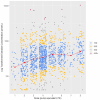The range and variation in serum estradiol concentration in perimenopausal and postmenopausal women treated with transdermal estradiol in a real-world setting: a cross-sectional study
- PMID: 39689249
- PMCID: PMC12147738
- DOI: 10.1097/GME.0000000000002459
The range and variation in serum estradiol concentration in perimenopausal and postmenopausal women treated with transdermal estradiol in a real-world setting: a cross-sectional study
Abstract
Objectives: The aims of the study are to explore the range and variation in serum estradiol concentration, and to estimate the prevalence of "poor absorption" (women using licensed estradiol doses with subtherapeutic levels), in perimenopausal and postmenopausal women using transdermal estradiol in the real world.
Methods: This is a cross-sectional analysis in a specialist menopause clinic in the UK.
Results: Serum samples were obtained from 1,508 perimenopausal and postmenopausal women. A total of 61.87% were using licensed doses. The median estradiol concentration was 355.26 pmol/L (interquartile range 198.44-646.15 pmol/L). A reference interval for the whole cohort was defined as 54.62-2,050.55 pmol/L. There was substantial interindividual variation across the dose range. Variance was greater in younger women ( P = 0.002) and gel users ( P = 0.002). There was a trend toward greater variance in women using higher doses, but the association failed to reach statistical significance ( P = 0.074). One in four women (24.84%) using the highest licensed dose had subtherapeutic levels (<200 pmol/L). Older women (≥50 y) and patch users were more likely to have low levels (odds ratio 1.77, 95% confidence interval 1.22-2.62, P = 0.003; and odds ratio 1.51, 95% confidence interval 1.18-1.95, P = 0.001, respectively).
Conclusions: The reference interval for perimenopausal and postmenopausal women using on-label and off-label doses of transdermal estradiol in the real world is wide, and there is considerable interindividual variation. The number of estradiol users with low estradiol levels (<200 pmol/L) is higher than previously recognized. Measurement of serum estradiol can be helpful to identify women who may benefit from an off-label dose. Dose customization is key to ensure that all women can reap the benefits of HT.
Copyright © 2024 by The Menopause Society.
Conflict of interest statement
Financial disclosure/conflicts of interest: Lynsey McColl has an ongoing relationship with Newson Health Ltd, via her company Select Statistical Services Ltd providing statistical analysis and support as a consultant. The other authors have nothing to disclose.
Figures



References
-
- Department of Health and Social Care. Caulfield M, Barclay S. Hundreds of thousands of women experiencing menopause symptoms to get cheaper HRT. Available at: http://www.gov.uk/government/news/hundreds-of-thousands-of-women-experie.... Accessed March 17, 2023.
MeSH terms
Substances
LinkOut - more resources
Full Text Sources

